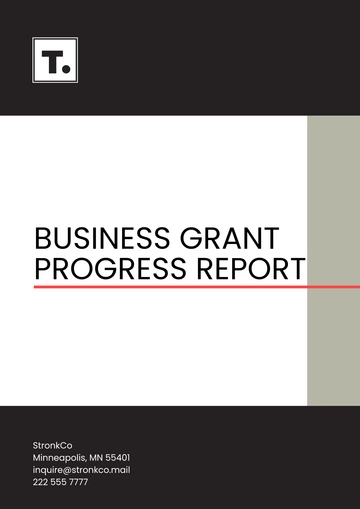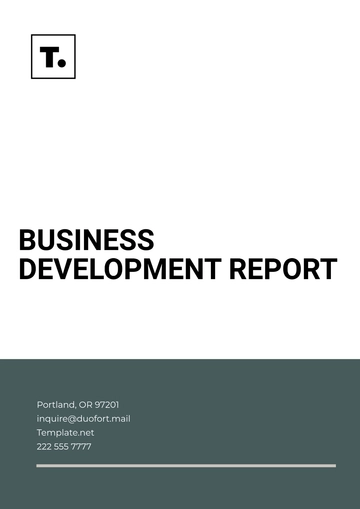Free Business Report

Prepared by: [Your Name]
Date: [Date]
I. Executive Summary
This field report provides an overview of the business project's current performance at [Your Company Name]. The study was conducted to evaluate the impact of recent process improvements on operational efficiency and customer satisfaction. Key findings show that while the process improvements have positively affected internal efficiency, customer satisfaction levels remain stagnant. Based on these findings, the report recommends changes to customer engagement strategies and operational procedures to achieve better outcomes.
II. Introduction
This field report aims to assess the outcomes of [Your Company Name]'s recent process improvement initiatives. This report aims to provide insights into how these improvements have affected both operational efficiency and customer satisfaction. The scope of the report covers the period from January 2050 to September 2050 and includes data collected through interviews, surveys, and direct observation at the company's headquarters and various operational sites.
III. Methodology
Data for this report was collected using a combination of quantitative and qualitative methods, including:
A. Data Collection
Interviews: Conducted with department heads, team leads, and front-line employees to gather insights into operational changes.
Surveys: Sent to 500 customers to measure satisfaction before and after the process improvements.
Direct Observations: A field team observed daily operations at two key locations to assess efficiency and employee performance.
Internal Reports: Financial and operational reports were reviewed to evaluate key performance indicators (KPIs).
B. Data Analysis
Quantitative data was analyzed using statistical tools to identify trends, while qualitative data from interviews and surveys were coded for thematic analysis.
IV. Findings/Observations
The following key findings emerged from the data collected:
A. Operational Efficiency
There was a 15% reduction in process time for key operations, such as product assembly and customer order processing.
Employee productivity has improved by 10% due to new software and task automation.
Inventory management has become more accurate, with a 20% reduction in stock discrepancies.
B. Customer Satisfaction
Customer satisfaction scores, based on post-transaction surveys, showed no significant increase after process improvements.
30% of surveyed customers reported dissatisfaction with response times for customer support, which remained consistent despite operational changes.
10% of customers cited product quality as a concern, which was unrelated to the process changes.
V. Analysis
The improvements in operational efficiency have led to measurable gains in productivity and cost savings. However, these gains have not translated into improved customer satisfaction, suggesting that the process changes, while beneficial internally, have not sufficiently addressed external customer-facing issues. The stagnation in customer satisfaction can be attributed to several factors:
A. Limited Impact on Customer Experience
The operational changes focused primarily on back-end processes, such as production and logistics, without addressing front-line customer service or product quality issues.
Customer support and communication remain the primary areas of concern for a significant portion of the customer base.
B. Communication Gaps
There is a lack of clear communication between departments, particularly between the operations team and customer service representatives, which affects the customer experience.
VI. Recommendations
To address the findings and improve overall business performance, the following recommendations are made:
A. Enhance Customer Support
Implement a new customer relationship management (CRM) system to streamline communication and response times for support teams.
Offer additional training to customer support representatives, focusing on effective problem-solving and customer engagement.
B. Improve Product Quality
Conduct a quality audit on the production line to identify and eliminate recurring product issues that contribute to customer dissatisfaction.
Establish a continuous improvement program that includes customer feedback loops to monitor and enhance product quality.
C. Strengthen Cross-Departmental Communication
Facilitate regular cross-functional meetings between the operations and customer service teams to ensure a more seamless customer experience.
Implement a centralized communication platform that can provide real-time updates to customer service on inventory and product availability.
VII. Conclusion
While [Your Company Name]'s process improvements have led to notable operational efficiencies, these gains have not been mirrored in customer satisfaction levels. To truly capitalize on the improvements and create a more holistic impact, the company must focus on strengthening customer service and product quality. By addressing these areas, [Your Company Name] can enhance both internal efficiency and external customer satisfaction, leading to sustained growth and competitive advantage.
VIII. Appendices
Appendix A: Customer Satisfaction Survey Results
A detailed breakdown of survey results, including specific customer comments and satisfaction ratings.
Appendix B: Operational Efficiency Metrics
A chart showing the improvements in process time and employee productivity before and after the implementation of process changes.
Appendix C: Interview Transcripts
Summarized notes and transcripts from interviews with department heads and employees.
- 100% Customizable, free editor
- Access 1 Million+ Templates, photo’s & graphics
- Download or share as a template
- Click and replace photos, graphics, text, backgrounds
- Resize, crop, AI write & more
- Access advanced editor
This Business Report Template from Template.net is a fully customizable and editable solution for recording business field data. Designed for professionals, it helps organize and document reports efficiently. Editable in our Ai Editor Tool, you can easily modify sections to fit your specific business needs. Download, customize, and streamline your reporting process effortlessly.
You may also like
- Sales Report
- Daily Report
- Project Report
- Business Report
- Weekly Report
- Incident Report
- Annual Report
- Report Layout
- Report Design
- Progress Report
- Marketing Report
- Company Report
- Monthly Report
- Audit Report
- Status Report
- School Report
- Reports Hr
- Management Report
- Project Status Report
- Handover Report
- Health And Safety Report
- Restaurant Report
- Construction Report
- Research Report
- Evaluation Report
- Investigation Report
- Employee Report
- Advertising Report
- Weekly Status Report
- Project Management Report
- Finance Report
- Service Report
- Technical Report
- Meeting Report
- Quarterly Report
- Inspection Report
- Medical Report
- Test Report
- Summary Report
- Inventory Report
- Valuation Report
- Operations Report
- Payroll Report
- Training Report
- Job Report
- Case Report
- Performance Report
- Board Report
- Internal Audit Report
- Student Report
- Monthly Management Report
- Small Business Report
- Accident Report
- Call Center Report
- Activity Report
- IT and Software Report
- Internship Report
- Visit Report
- Product Report
- Book Report
- Property Report
- Recruitment Report
- University Report
- Event Report
- SEO Report
- Conference Report
- Narrative Report
- Nursing Home Report
- Preschool Report
- Call Report
- Customer Report
- Employee Incident Report
- Accomplishment Report
- Social Media Report
- Work From Home Report
- Security Report
- Damage Report
- Quality Report
- Internal Report
- Nurse Report
- Real Estate Report
- Hotel Report
- Equipment Report
- Credit Report
- Field Report
- Non Profit Report
- Maintenance Report
- News Report
- Survey Report
- Executive Report
- Law Firm Report
- Advertising Agency Report
- Interior Design Report
- Travel Agency Report
- Stock Report
- Salon Report
- Bug Report
- Workplace Report
- Action Report
- Investor Report
- Cleaning Services Report
- Consulting Report
- Freelancer Report
- Site Visit Report
- Trip Report
- Classroom Observation Report
- Vehicle Report
- Final Report
- Software Report





























